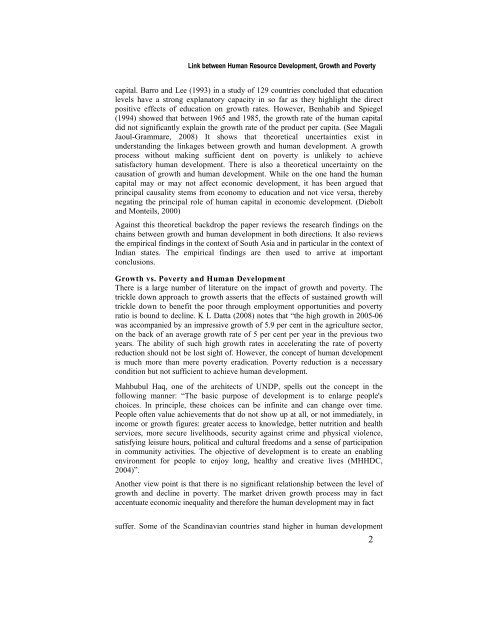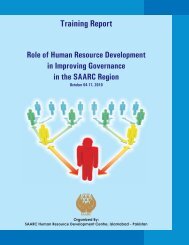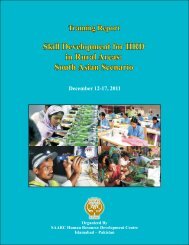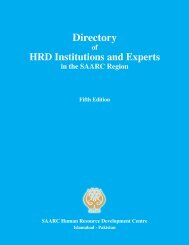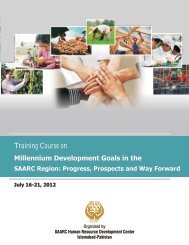Here - SAARC Human Resource Development Centre
Here - SAARC Human Resource Development Centre
Here - SAARC Human Resource Development Centre
- No tags were found...
You also want an ePaper? Increase the reach of your titles
YUMPU automatically turns print PDFs into web optimized ePapers that Google loves.
Link between <strong>Human</strong> <strong>Resource</strong> <strong>Development</strong>, Growth and Povertycapital. Barro and Lee (1993) in a study of 129 countries concluded that educationlevels have a strong explanatory capacity in so far as they highlight the directpositive effects of education on growth rates. However, Benhabib and Spiegel(1994) showed that between 1965 and 1985, the growth rate of the human capitaldid not significantly explain the growth rate of the product per capita. (See MagaliJaoul-Grammare, 2008) It shows that theoretical uncertainties exist inunderstanding the linkages between growth and human development. A growthprocess without making sufficient dent on poverty is unlikely to achievesatisfactory human development. There is also a theoretical uncertainty on thecausation of growth and human development. While on the one hand the humancapital may or may not affect economic development, it has been argued thatprincipal causality stems from economy to education and not vice versa, therebynegating the principal role of human capital in economic development. (Dieboltand Monteils, 2000)Against this theoretical backdrop the paper reviews the research findings on thechains between growth and human development in both directions. It also reviewsthe empirical findings in the context of South Asia and in particular in the context ofIndian states. The empirical findings are then used to arrive at importantconclusions.Growth vs. Poverty and <strong>Human</strong> <strong>Development</strong>There is a large number of literature on the impact of growth and poverty. Thetrickle down approach to growth asserts that the effects of sustained growth willtrickle down to benefit the poor through employment opportunities and povertyratio is bound to decline. K L Datta (2008) notes that “the high growth in 2005-06was accompanied by an impressive growth of 5.9 per cent in the agriculture sector,on the back of an average growth rate of 5 per cent per year in the previous twoyears. The ability of such high growth rates in accelerating the rate of povertyreduction should not be lost sight of. However, the concept of human developmentis much more than mere poverty eradication. Poverty reduction is a necessarycondition but not sufficient to achieve human development.Mahbubul Haq, one of the architects of UNDP, spells out the concept in thefollowing manner: “The basic purpose of development is to enlarge people'schoices. In principle, these choices can be infinite and can change over time.People often value achievements that do not show up at all, or not immediately, inincome or growth figures: greater access to knowledge, better nutrition and healthservices, more secure livelihoods, security against crime and physical violence,satisfying leisure hours, political and cultural freedoms and a sense of participationin community activities. The objective of development is to create an enablingenvironment for people to enjoy long, healthy and creative lives (MHHDC,2004)”.Another view point is that there is no significant relationship between the level ofgrowth and decline in poverty. The market driven growth process may in factaccentuate economic inequality and therefore the human development may in factsuffer. Some of the Scandinavian countries stand higher in human development2


